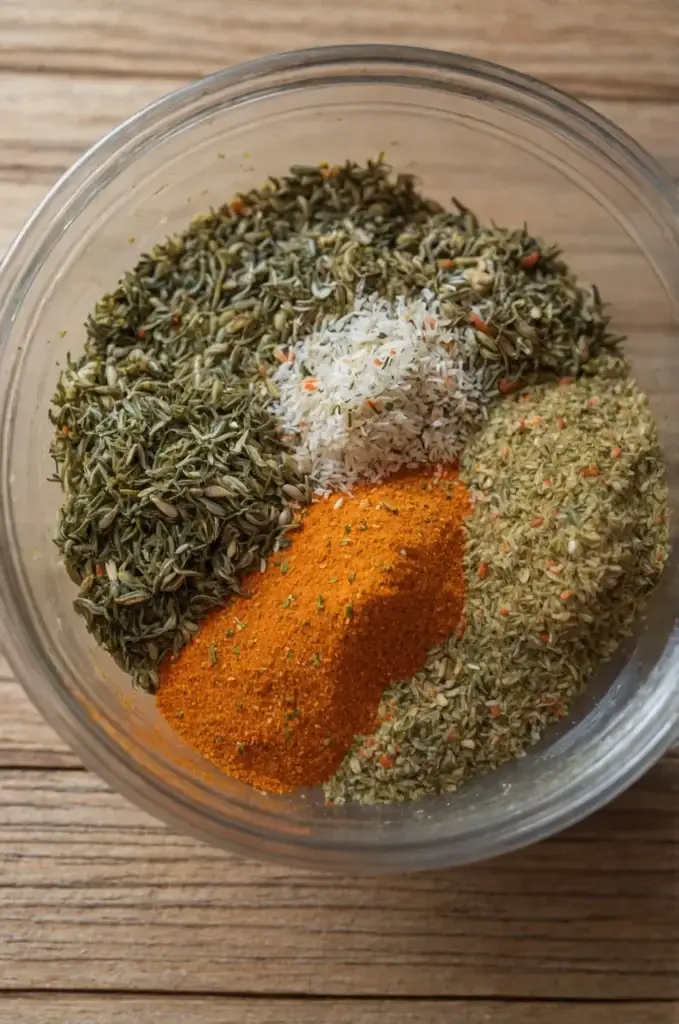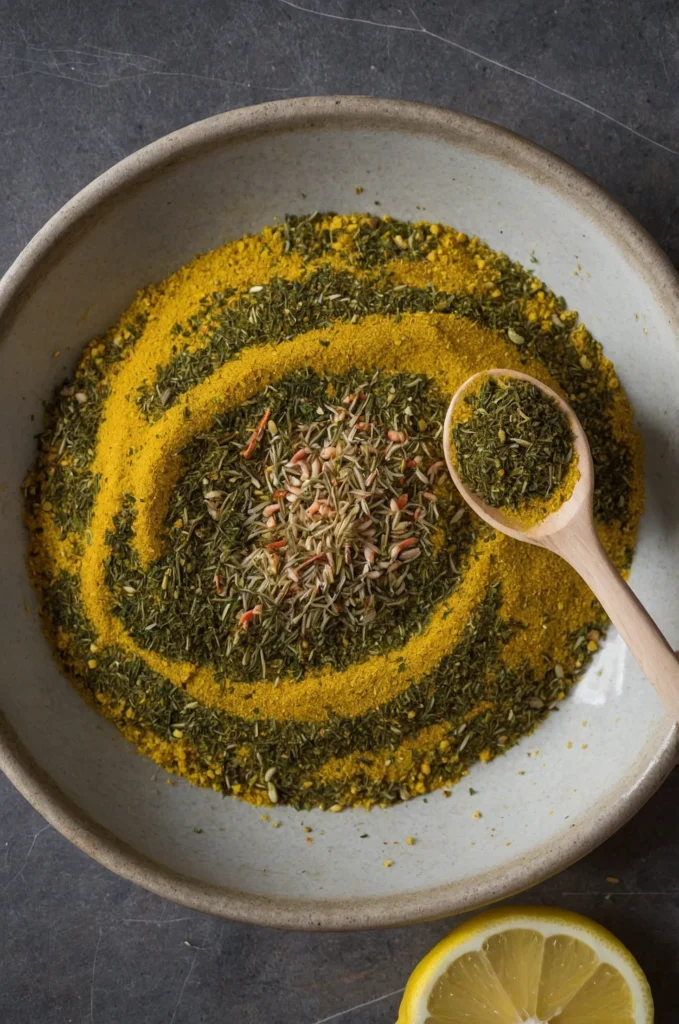The Only Seafood Seasoning Recipe You’ll Ever Need (+ Variations!)
Discover how to make the perfect seafood seasoning at home with simple pantry ingredients. Elevate your fish, shrimp, and crab dishes with this versatile spice blend

Are you tired of reaching for store-bought seafood seasoning that’s either salty, not flavorful enough, or filled with ingredients you can’t pronounce? Creating your homemade seafood seasoning isn’t just economical—it’s a game-changer for your cooking. With just a few minutes and spices you likely already have in your pantry, you can craft a custom blend that rivals (or even surpasses) those expensive store-bought options.
In this comprehensive guide, I’ll walk you through creating the perfect foundational seafood seasoning, plus show you how to customize it into popular variations, including Old Bay style, Cajun, and refreshing lemon herb blends. You’ll also discover clever ways to use your homemade seasoning beyond the obvious seafood applications and learn professional storage tips to maintain maximum flavor.
Content Overview
Table of Contents
Whether you’re a seafood enthusiast looking to elevate your shrimp boil or simply want more control over the ingredients in your spice cabinet, this homemade seafood seasoning recipe collection is your ultimate resource.
What IS Seafood Seasoning? (Understanding the Basics)
Before diving into recipes, let’s understand what makes a great seafood seasoning. At its core, a quality seafood seasoning features a balanced blend of savory, salty, and slightly spicy elements. Most traditional seafood seasonings are paprika or celery salt forward, creating that distinctive flavor that complements rather than overpowers delicate seafood flavors.
When most people think of seafood seasoning, Old Bay immediately comes to mind. This iconic blend has dominated the market for decades with its distinctive mix of herbs and spices, including celery salt, red pepper, black pepper, and paprika. However, regional variations exist across coastal communities—from the bold, fiery Cajun blends of Louisiana to the lighter, herb-forward Mediterranean profiles.
The beauty of making your seafood seasoning is understanding these foundations while having the freedom to create something perfectly suited to your palate.
Why Make Your Seafood Seasoning?
Creating your seafood seasoning offers numerous advantages over store-bought alternatives:
- Control Sodium Levels: Commercial blends often contain excessive salt. Making your own allows you to adjust the sodium content to suit dietary needs.
- Customize Heat Levels: Love spice? Dial up the cayenne. Prefer milder flavors? Reduce or omit the hot elements entirely.
- Experience Fresher Flavors: Homemade blends using recently purchased spices deliver brighter, more vibrant flavors than mass-produced options that may have been sitting on shelves for months.
- Avoid Additives: Many commercial seasonings contain preservatives, anti-caking agents, or MSG. Your homemade version can be completely natural.
- Save Money: Ounce for ounce, creating your blend is significantly more cost-effective, especially if you buy spices in bulk.
- Perfect Customization: Adjust any element to suit your family’s preferences or dietary restrictions.
Once you discover how simple it is to make your seafood seasoning—and how superior the results are—you’ll likely never go back to the pre-made versions again.
Discover more Seafood Recipes
The “Famous” Foundational Seafood Seasoning Recipe
This base recipe creates a versatile, well-balanced seafood seasoning that works wonderfully with all kinds of fish and shellfish. Consider this your starting point for seafood seasoning greatness!
Ingredients You’ll Need
- 2 tablespoons paprika (for vibrant color and mild sweetness)
- 2 tablespoons celery salt (provides the signature flavor foundation)
- 1 tablespoon ground black pepper (adds essential warmth and bite)
- 1 teaspoon cayenne pepper (delivers gentle heat that complements seafood)
- 1 teaspoon dry mustard powder (contributes subtle tanginess and depth)
- 1 teaspoon ground ginger (adds aromatic warmth)
- 1 teaspoon dried oregano (provides herbal notes)
- 1 teaspoon dried thyme (complements seafood naturally)
- 1 teaspoon garlic powder (enhances savory dimension)
- 1 teaspoon onion powder (adds rounded flavor)
- ½ teaspoon ground allspice (contributes subtle warming complexity)
- ½ teaspoon ground cardamom (adds a unique citrusy, aromatic quality)
Step-by-Step Instructions
- Measure all spices and herbs carefully into a small mixing bowl.
- Whisk thoroughly until the mixture appears uniform in color with no visible clumps.
- Transfer to a fine-mesh sieve and sift over another bowl to remove any remaining lumps (optional but recommended).
- Pour the finished seasoning into an airtight container for storage.
Equipment Needed
- Measuring spoons
- Small mixing bowl
- Whisk or fork for blending
- Fine-mesh sieve (optional)
- An airtight glass jar or spice container for storage
This foundation recipe creates approximately ½ cup of seasoning, which will season approximately 8-10 pounds of seafood, depending on how liberally you apply it.
Master Popular Seafood Seasoning Variations (Customize Your Blend!)
The beauty of creating your own seafood seasoning lies in the ability to adapt it to different culinary styles and preferences. Here’s how to modify the base recipe to create several popular variations.
Classic “Old Bay Style” Seasoning Variation
For those seeking that iconic Maryland-style flavor profile that’s perfect for crab feasts and seafood boils:
Start with the base recipe above, then make these adjustments:
- Add: 1 teaspoon ground bay leaves (crucial for that authentic flavor)
- Add: ½ teaspoon ground cinnamon (adds subtle warmth)
- Add: ½ teaspoon ground cloves (enhances aromatic complexity)
- Add: ¼ teaspoon ground nutmeg (completes the signature flavor profile)
- Increase: Celery salt to 2½ tablespoons (for more pronounced celery flavor)
- Decrease: Black pepper to 2 teaspoons (for better balance)
This variation particularly shines with blue crab, shrimp boils, and crab cakes. The aromatic spices create that distinctive Old Bay character that seafood lovers immediately recognize.
Discover more Seafood Recipes
Spicy Cajun Seafood Seasoning Variation
Bring the bold, vibrant flavors of Louisiana to your seafood with this kicked-up variation:

Start with the base recipe above, then make these adjustments:
- Add: 1 tablespoon additional cayenne pepper (for significant heat)
- Add: 1 teaspoon dried oregano (reinforces herbal notes)
- Add: 1 teaspoon dried basil (adds complexity)
- Add: ½ teaspoon dried marjoram (complements the oregano beautifully)
- Add: ½ teaspoon smoked paprika (introduces pleasant smokiness)
- Increase: Garlic powder to 2 teaspoons (for more pronounced garlic flavor)
- Increase: Onion powder to 2 teaspoons (enhances savory qualities)
- Reduce: Celery salt to 1 tablespoon (balances the additional flavors)
This fiery version is perfect for crawfish boils, blackened fish, gumbo, or jambalaya. The heat builds gradually but isn’t overwhelming, allowing the complex flavors to shine through.
Bright Lemon Herb Seafood Seasoning Variation
For a lighter, brighter alternative that works beautifully with delicate white fish and grilled seafood:

Start with the base recipe above, then make these adjustments:
- Add: 1 tablespoon dried lemon zest (creates vibrant citrus notes)
- Add: 1 teaspoon dried dill (pairs beautifully with seafood)
- Add: 1 teaspoon dried parsley (adds fresh, green notes)
- Add: ½ teaspoon white pepper (provides milder heat)
- Reduce: Paprika to 1 teaspoon (for a lighter color and flavor profile)
- Reduce: Cayenne to ¼ teaspoon (for subtle background warmth)
- Omit: Allspice and cardamom (for a cleaner flavor profile)
This refreshing variation complements grilled shrimp, baked fish, and seafood pasta dishes. The citrus notes brighten the seafood without overwhelming it.
Low Sodium Seafood Seasoning Tips
For those monitoring sodium intake, seafood seasoning can still be delicious without excessive salt:
- Replace celery salt with 1 tablespoon celery seed and adjust salt separately to taste (starting with ½ teaspoon).
- Increase garlic powder and onion powder to 1½ teaspoons each for more flavor depth.
- Add 1 teaspoon citric acid or sumac for tangy brightness that makes you notice the salt less.
- Enhance with 1 tablespoon nutritional yeast for umami richness (this helps compensate for reduced salt).
- Consider adding ½ teaspoon of a salt-free seasoning blend like Mrs. Dash as a complement.
This variation maintains flavor complexity while significantly reducing sodium content—perfect for those on salt-restricted diets who still want vibrant seafood flavors.
How to Use Your Homemade Seafood Seasoning (Beyond the Obvious!)
Your versatile seafood seasoning deserves to be used in more ways than simply sprinkling it on fish! Here are creative applications to get maximum value from your homemade blend:
- Classic Fish & Shellfish: Sprinkle liberally on fish fillets, shrimp, scallops, or lobster before grilling, baking, or pan-searing
- Seafood Boils: Add 2-3 tablespoons to water when boiling shrimp, crab, or crawfish (along with lemon and aromatics)
- Seafood Cakes & Patties: Incorporate 1-2 teaspoons into crab cake, salmon cake, or fish patty mixtures
- Creamy Dips: Blend 1 teaspoon into cream cheese-based seafood dips or spreads
- Seafood Soups: Enhance chowders, bisques, or cioppino with ½-1 teaspoon per quart of soup
- Compound Butter: Mix 1 teaspoon into softened butter with lemon zest for an incredible topping for grilled fish or to slather on corn on the cob
- Roasted Vegetables: Sprinkle on potato wedges, corn, or mixed vegetables before roasting
- Bloody Mary Rim: Mix with salt to create a flavorful rim for seafood-friendly cocktails
- Deviled Eggs: Add ¼ teaspoon to deviled egg filling for a flavor-packed appetizer
- Pasta Dishes: Sprinkle into seafood pasta or risotto for enhanced flavor
- Popcorn Seasoning: Mix with melted butter for a unique savory popcorn topping
- Seafood Stuffing: Add to bread stuffing for stuffed fish or shellfish
The versatility of this seasoning blend extends far beyond seafood, making it a true workhorse in your kitchen arsenal.
Storage Tips for Maximum Freshness
To maintain optimal flavor and potency of your homemade seafood seasoning:
- Choose the Right Container: Store in an airtight glass jar with a tight-fitting lid—avoid plastic containers which can absorb flavors and compromise freshness.
- Location Matters: Keep in a cool, dark place away from heat sources like your stove or direct sunlight.
- Avoid Moisture: Always use a completely dry measuring spoon when scooping from your container to prevent introducing moisture.
- Proper Labeling: Label your container with the contents, variation name, and date made.
- Freshness Timeline: While your seasoning won’t “spoil,” its potency gradually diminishes. For best flavor, use within 6 months.
- Vacuum Sealing: For longer-term storage, consider vacuum-sealing larger batches in smaller portions.
Pro tip: If you live in a particularly humid climate, add a few grains of raw rice to your storage container. These will absorb excess moisture and help prevent clumping.
Discover more Seafood Recipes
Pro Tips for the BEST Seafood Seasoning
Elevate your homemade seafood seasoning from good to exceptional with these professional insights:
- Quality Matters: Use the freshest spices possible—consider replacing your ground spices every 6-12 months for maximum potency.
- Toast Whole Spices: For deeper flavor, toast whole spices like celery seed, peppercorns, and cardamom pods in a dry skillet until fragrant before grinding.
- Grind Fresh: Invest in a dedicated spice grinder for whole spices to experience truly vibrant flavor that pre-ground spices can’t deliver.
- Test Before Scaling: Always make a small test batch of a new variation before creating a large amount—this allows you to adjust to your taste preferences.
- Incremental Adjustments: When customizing, add heat elements like cayenne gradually—you can always add more, but you can’t take them out.
- Texture Considerations: For applications like seafood rubs, a slightly coarser grind works beautifully; for incorporating into batters or doughs, a finer grind is preferable.
- Blend in Batches: When making larger quantities, mix in batches and then combine to ensure even distribution of all spices.
Remember that seafood seasonings should enhance rather than overwhelm the natural flavors of your seafood. The perfect blend complements without competing.
Frequently Asked Questions (FAQ)
What is a substitute for Old Bay seasoning?
Our “Classic Old Bay Style” variation makes an excellent substitute. If you’re in a pinch with limited ingredients, a simplified version can be made with 1 tablespoon each of paprika and celery salt, 1 teaspoon each of black pepper and cayenne, and ½ teaspoon dry mustard.
Is seafood seasoning the same as Cajun seasoning?
No. While both can be used on seafood, traditional seafood seasoning tends to be celery-forward with warming spices, while Cajun seasoning is typically spicier with more emphasis on garlic, onion, and herbs like oregano and thyme. Our Cajun variation bridges this gap by building on our seafood seasoning base.
Can I make this seasoning less salty?
Absolutely! Follow our low-sodium variation guidelines, which replace celery salt with celery seed and allow you to control salt levels separately.
How long does homemade seafood seasoning last?
When stored properly in an airtight container in a cool, dark place, your homemade seasoning will maintain optimal flavor for 6 months. It remains safe to use indefinitely but may gradually lose potency after 6-12 months.
Can I use fresh herbs instead of dried in seafood seasoning?
Fresh herbs aren’t recommended for dry seasoning blends as they introduce moisture that can cause spoilage. Stick with dried herbs for your blend.
What’s the best seafood seasoning for grilled fish?
For grilled fish, our Lemon Herb variation is exceptional as the bright citrus notes complement the natural smokiness from grilling without overpowering delicate fish.
How much seafood seasoning should I use?
As a general guideline, use approximately 1 tablespoon per pound of seafood. However, this varies by application—for direct seasoning (like on fish fillets), use less; for boils or soups, use more.
Is homemade seafood seasoning gluten-free?
Yes, all our recipes are naturally gluten-free. However, always check individual spice packaging if you have severe gluten sensitivities, as some commercial spices may be processed in facilities that also handle wheat products.
Perfect Pairings: What Goes Well with Seafood Seasoning
| Seafood Type | Best Seasoning Variation | Perfect Sides |
|---|---|---|
| Shrimp | Classic or Cajun | Corn on the cob, potato salad |
| Crab | Old Bay Style | Coleslaw, hushpuppies |
| Mild White Fish | Lemon Herb | Roasted vegetables, rice pilaf |
| Salmon | Classic or Low Sodium | Asparagus, quinoa |
| Lobster | Classic with extra lemon zest | Drawn butter, crusty bread |
| Scallops | Lemon Herb | Risotto, wilted greens |
| Crawfish | Cajun | Corn, potatoes, andouille |
Your Homemade Seafood Seasoning Adventure Begins
Creating your seafood seasoning is more than just a money-saving kitchen hack—it’s an opportunity to craft a signature blend that perfectly suits your taste preferences. Whether you’re hosting a seafood boil, preparing a quick weeknight fish dinner, or looking to add flavor to vegetables and more, having these versatile blends on hand will elevate your cooking.
The best part about homemade seasoning is that it’s never set in stone. Feel free to adjust any recipe, taking notes on your changes until you’ve created your perfect blend. Your culinary creativity is the only limit!
What will you season first with your homemade blend? Will you start with the classic foundational recipe or jump straight to one of the variations? Whatever you choose, I’d love to hear about your seafood seasoning adventures in the comments below!
Discover more Seafood Recipes
Recipe Card: Classic Homemade Seafood Seasoning
Prep Time: 10 minutes
Total Time: 10 minutes
Yield: Approximately ½ cup (16 servings)
Ingredients
- 2 tablespoons paprika
- 2 tablespoons celery salt
- 1 tablespoon ground black pepper
- 1 teaspoon cayenne pepper
- 1 teaspoon dry mustard powder
- 1 teaspoon ground ginger
- 1 teaspoon dried oregano
- 1 teaspoon dried thyme
- 1 teaspoon garlic powder
- 1 teaspoon onion powder
- ½ teaspoon ground allspice
- ½ teaspoon ground cardamom
Instructions
- Measure all spices and herbs into a small mixing bowl.
- Whisk thoroughly until the mixture appears uniform in color with no visible clumps.
- If desired, sift through a fine-mesh sieve to remove any lumps.
- Transfer to an airtight container.
- Label with name and date.
- Store in a cool, dark place for up to 6 months.
Notes
For variations, see the main article for Old Bay Style, Cajun, Lemon Herb, and Low Sodium adaptations.
Nutritional Information (per ¼ teaspoon serving): Calories: 5, Sodium: 120mg, Carbohydrates: 1g, Protein: 0g
